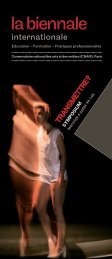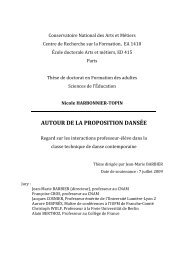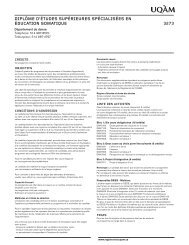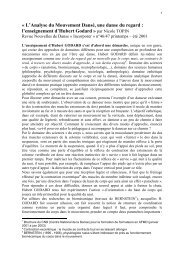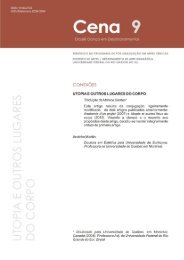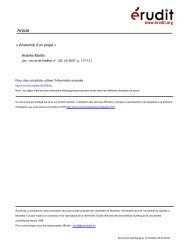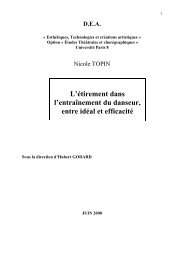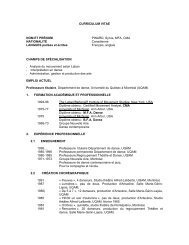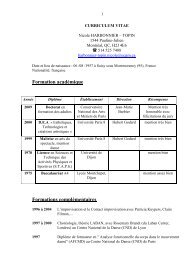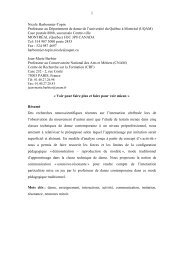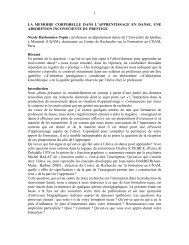Day 2 - Département de danse - UQAM
Day 2 - Département de danse - UQAM
Day 2 - Département de danse - UQAM
Create successful ePaper yourself
Turn your PDF publications into a flip-book with our unique Google optimized e-Paper software.
i<strong>de</strong>ntity. The artwork of Anthony Walsh and the Inkameep Children accurately exemplifies Homi Bhabha’s theory of “Third<br />
Space” communication.<br />
“Place since Time Immemorial in Kevin Loring’s Where the Blood Mixes.” Ginny Ratsoy<br />
(Thompson Rivers University)<br />
While not, strictly speaking, coastal theatre, Kevin Loring’s 2009 Governor General’s-award-winning play Where the Blood<br />
Mixes is certainly at/on the edge: set in a village in the BC Interior in a time close to the present, it draws heavily on the cultural<br />
past of the N’lakap’mux people as it <strong>de</strong>picts the relationship between humans and the non-human world as intricate and<br />
complex.<br />
Consi<strong>de</strong>ring the work of such scholars of ecocriticism as Una Chaudhuri, as well as Rob Appleford’s studies of earlier<br />
Aboriginal dramatists in Canada, I will explore the play’s construction of the natural world as a dynamic force, in line with<br />
Giannachi and Stewart’s conception (in Performing Nature: Explorations in Ecology and the Arts) of nature as “a process of<br />
endless exchange and interactivity between the human and the other-than human” (19). Loring ren<strong>de</strong>rs the landscape and its<br />
non-human inhabitants not only as a force inseparable from humans but also as a <strong>de</strong>vice to disrupt conventional Western<br />
notions of temporal distinctions.<br />
This paper contributes to the ongoing discussion of contemporary Indigenous drama by connecting it to scholarship on<br />
ecocriticism. I will also compare relevant elements of the play to Tomson Highway’s Ernestine Shuswap Gets Her Trout, which<br />
is also set in the B.C. Interior. Both plays live and breathe British Columbia landscape, contemporary and past. Although my<br />
examination is largely text focused, I will draw on the productions by Western Canada Theatre in Kamloops of Ernestine<br />
Shuswap Gets Her Trout (in 2004) and Where the Blood Mixes (in 2012).<br />
c) The State of Performance Research in Québec: A Summary of Current Thinking McIntyre<br />
on Theatre, Circus, Dance, and Performance Studies / Bilan <strong>de</strong>s étu<strong>de</strong>s actuelles<br />
en théâtre, cirque, performance et <strong>danse</strong> au Québec (Joint Session with Société<br />
québécoise d’étu<strong>de</strong>s théâtrales, ma<strong>de</strong> possible by the CFHSS Aid to Interdisciplinary<br />
Sessions Fund)<br />
Joint Session Mo<strong>de</strong>rator and Respon<strong>de</strong>nt: Erin Hurley (McGill University). Panelists: Louis Patrick<br />
Leroux (Concordia) on contemporary circus research, Hervé Guay (UQTR) and Yves Jubinville<br />
(<strong>UQAM</strong>) on current theatre research, Nicole Harbonnier (<strong>UQAM</strong>) on current dance research,<br />
Constanza-Suarez Camelo (UQAC) on current performance art research<br />
This panel will summarize, in English, current and emerging research on performance in Québec.<br />
The field of Theatre Studies has consi<strong>de</strong>rably wi<strong>de</strong>ned in Québec over the past few years, taking into account much of<br />
what Anglo-American cultural studies and performance studies have to offer, but also in light of more hybridized artistic<br />
practices from nouveau cirque to dance-theatre, and every variation theatre and performance art have to offer. While Québec<br />
has seen the burgeoning of inter-artistic forms, it has also set the stage for more confi<strong>de</strong>nt and varied intercultural productions.<br />
As for dramaturgy, the last few years have seen a renewed dialogue between playwriting and more visual scenic writing, as<br />
well as the emergence of clear-hea<strong>de</strong>d analysis in dramaturgy and aesthetics, finally coming together as complementary<br />
fields. This renewal of Theatre and Performance Studies in Québec isn’t without a few caveats, as traditional historical<br />
research and normative artistic practices have been overtaken by more contemporary and seemingly exciting objects of study<br />
for which scholars don’t necessarily have critical distance. Might this openness to new practices lead to a dissatisfaction with<br />
traditional forms and possibly discredit valid filiations, traditions, and less edgy text-based analysis? Moreover, we can ask<br />
ourselves whether i<strong>de</strong>ntity-driven issues are as central in Québec performance studies and what have truly become of the<br />
political, economic, and sociological aspects of Québec theatrical discourse and its analysis. Finally, the international notoriety<br />
of an increasing number of Québec companies and individual artists has increased the number of foreign research on Québec<br />
(though English Canada might not be as interested as it used to be). What is the impact of this foreign research on the field of<br />
study in Québec and how do Québec scholars read (or do they) this scholarship from abroad? These are some of the<br />
questions which will inform the papers of this curated panel, which will en<strong>de</strong>avor to present to English-Canadian scholars<br />
some of the trends, issues, and questions current in theatre scholarship in Québec.<br />
Le domaine <strong>de</strong>s étu<strong>de</strong>s théâtrales s’est passablement diversifié au Québec ces <strong>de</strong>rnières années sous l’impulsion <strong>de</strong>s<br />
« cultural studies » et <strong>de</strong>s « performance studies » mais aussi en raison <strong>de</strong> pratiques plus métissées telles que le « nouveau<br />
cirque », la <strong>danse</strong>-théâtre ou les divers allers-retours entre théâtre et performance. Si le Québec a vu l’éclosion <strong>de</strong> formes <strong>de</strong><br />
plus en plus interartistiques, il a aussi été témoin <strong>de</strong> l’affermissement <strong>de</strong> pratiques interculturelles prenant diverses formes.<br />
Pour ce qui est du texte dramatique, les <strong>de</strong>rnières années ont aussi été marquées par <strong>de</strong> multiples tentatives <strong>de</strong><br />
renouvellement du dialogisme scénique qui ont stimulé l’essor <strong>de</strong>s analyses en dramaturgie et en esthétique, désormais<br />
moins vues comme <strong>de</strong>s domaines séparés que perçues comme complémentaires. Ce renouvellement <strong>de</strong>s étu<strong>de</strong>s théâtrales<br />
et spectaculaires n’est pas sans poser <strong>de</strong>s questions relativement à l’espace qu’y occupent désormais l’histoire du théâtre et<br />
l’étu<strong>de</strong> <strong>de</strong>s pratiques plus traditionnelles, le champ semblant privilégier <strong>de</strong>s objets <strong>de</strong> plus en plus contemporains pour<br />
lesquels les chercheurs n’ont souvent plus la distance nécessaire pour procé<strong>de</strong>r à une mise en contexte suffisante. D’ailleurs,<br />
cette ouverture à la nouveauté et aux autres arts ne risque-t-elle <strong>de</strong> conduire à une prise en compte insatisfaisante <strong>de</strong>s<br />
filiations et <strong>de</strong>s héritages, à la minoration <strong>de</strong>s pratiques populaires ou monolithiques, voire simplement basées sur le texte<br />
plutôt que la représentation ? En outre, on peut se <strong>de</strong>man<strong>de</strong>r si les questions i<strong>de</strong>ntitaires <strong>de</strong>meurent toujours aussi centrales<br />
dans les étu<strong>de</strong>s québécoises <strong>de</strong> la représentation et quelle est la part du politique, <strong>de</strong> l’économique et du sociologique dans<br />
11



